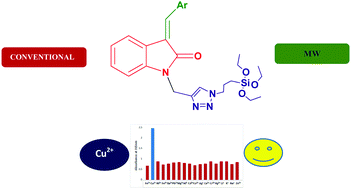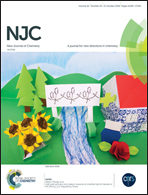Chalcone scaffolds as photofunctional hybrid material of indolin-2-one-functionalized siloxy framework for optical sensing of Cu2+†
Abstract
Owing to their easy approachability and high degree of structural and functional diversity, many multicomponent reactions such as 1,3-dipolar cycloaddition have been a rich source of conjugated π-systems, functionalised chromophores and active molecules. Despite their high potential for investigation and practical benefits, few products have thus far been scrutinized for their metal sensing abilities. In the present study, indolin-2-one chalcones bearing siloxy molecular systems were synthesized by a [2+3] cycloaddition-based reaction sequence. A designed chemosensor exhibited an optical (absorption spectra) response toward Cu2+ ions in an acetonitrile solution. Different aspects of the sensing phenomena such as selectivity and association constants were studied in detail using UV-vis spectroscopy. The calibration plot was linear (R2 = 0.9966) over a large range of Cu2+ ion concentrations (10 μM). This novel effort has initiated a well-organized method for the efficient improvement of cation sensors with triazole for detecting heavy metal pollutants in environmental and healthcare fields on a large scale.



 Please wait while we load your content...
Please wait while we load your content...